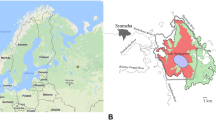Abstract
Comparisons were made of niche breadths and niche overlaps of halophytes growing in two emergent saltmarsh communities differing in the number of their constituent species and in diversity. Niche parameters were calculated along the major niche dimension of tidal inundation which was assessed using three related measurements, namely height on the marsh, number of submergences per year, and longest period of continuous exposure. This reduces the danger of measuring niches on one resource dimension along which species exhibit non-linear responses. Results obtained using these three measurements were very similar. Mean niche overlaps were significantly smaller, and most species had lower niche breadths, on the marsh with more diverse vegetation. These results agree with Pianka's (1974) niche overlap hypothesis; they indicate that competitive interactions between species are acting with different intensity on the two marshes, and that such interactions are important in determining the distribution limits of both low-and high-marsh species in the emergent salt-marsh community.
Similar content being viewed by others
References
Adam, P., 1978. Geographical variation in British saltmarsh vegetation. J. Ecol. 66: 339–366.
Adams, D. A., 1963. Factors influencing vascular plant zonation in North Carolina salt marshes. Ecology 44: 445–456.
Chapman, V. J., 1960. Salt Marshes and Salt Deserts of the World. Leonard Hill, London.
Clapham, A. R., Tutin, T. G. & Warburg, E. F., 1962. Flora of the British Isles, 2nd ed. Cambridge University Press, London.
Colwell, R. K., 1969. Ecological specialization and species diversity of tropical and temperate arthropods. Ph.D. Thesis, Univ. Michigan, Ann Arbor.
Colwell, R. K. & Futuyma, D. J., 1971. On the measurement of niche breadth and overlap. Ecology 52: 567–576.
Glasser, J. W. & Price, H. J., 1982. Niche theory: new insights from an old paradigm. J. Theor. Biol. 99: 437–460.
Grubb, P. J., 1977. The maintenance of species-richness in plant communities: the importance of the regeneration niche. Biol. Rev. 52: 107–145.
Hinde, H. P., 1954. The vertical distribution of salt marsh phanerogams in relation to tide levels. Ecol. Monogr. 24: 209–225.
Hutchinson, G. E., 1957. Concluding remarks. Cold Spring Harbor Symp. Quant. Biol. 22: 415–427.
Krebs, C. J., 1972. Ecology: The Experimental Analysis of Distribution and Abundance. Harper & Row, New York.
Lawrey, J. D., 1981. Evidence for competitive release in simplified saxicolous lichen communities. Am. J. Bot. 68: 1066–1073.
Levins, R., 1968. Evolution in Changing Environments: Some Theoretical Explorations. Princeton Univ. Press, New Jersey.
MacArthur, R. H., 1972. Geographical Ecology: Patterns in the Distribution of Species. Harper & Row, New York.
Pianka, E. R., 1973. The structure of lizard communities. Ann. Rev. Ecol. Syst. 4: 53–74.
Pianka, E. R., 1974. Niche overlap and diffuse competition. Proc. Natl. Acad. Sci. U.S.A. 71: 2141–2145.
Pickett, S. T. A., 1980. Non-equilibrium coexistence of plants. Bull. Torrey Bot. Club 107: 238–246.
Pielou, E. C. & Routledge, R. D., 1976. Salt marsh vegetation: latitudinal gradients in the zonation patterns. Oecologia 24: 311–321.
Platt, W. J. & Weis, I. M., 1977. Resource partitioning and competition within a guild of fugitive prairie plants. Am. Nat. 111: 479–513.
Ranwell, D. S., 1972. Ecology of Salt Marshes and Sand Dunes. Chapman & Hall, London.
Russell, P. J., 1983. A study of the niche dimensions of halophytes growing on salt marshes in Chichester harbour, England. D.Phil. Thesis, University of Sussex.
Siegel, S., 1956. Nonparametric Statistics for the Behavioural Sciences. McGraw Hill, Kogakusha Limited, Tokyo, Japan.
Southwood, T. R. E., 1966. Ecological Methods with Particular Reference to the Study of Insect Populations. Methuen, London.
Vandermeer, J. H., 1972. Niche theory. Ann. Rev. Ecol. Syst. 3: 107–132.
Yeaton, R. I. & Cody, M. L., 1979. The distribution of cacti along environmental gradients in the Sonoran and Mohave deserts. J. Ecol. 67: 529–541.
Author information
Authors and Affiliations
Additional information
Nomenclature follows Clapham, Tutin & Warburg (1962).
Acknowledgements. The authors gratefully acknowledge a travel grant from the British Council enabling them to attend the conference. The work was conducted whilst P.J.R. was in receipt of a Natural Environment Research Council studentship.
Rights and permissions
About this article
Cite this article
Russell, P.J., Flowers, T.J. & Hutchings, M.J. Comparison of niche breadths and overlaps of halophytes on salt marshes of differing diversity. Vegetatio 61, 171–178 (1985). https://doi.org/10.1007/BF00039822
Accepted:
Issue Date:
DOI: https://doi.org/10.1007/BF00039822




